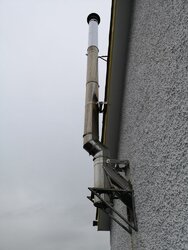Hi all,
My mother got a new stove and ss flue fitted in the summer but has experienced a lot of staining on the flue. It looks like the gasses are condensing at the top of the flue and the resulting goo is running down the outside.
Ive checked the following :
She's using smokeless stove coal
The fire is burning well with good draw and heat
There's no air leaks anywhere
Stove is a Stanley oisin
Can anyone help , pic attached (the clean section at the top had just been fitted by the installer in an attempt to fix the problem it's now in the same state as the rest)
Thanks
My mother got a new stove and ss flue fitted in the summer but has experienced a lot of staining on the flue. It looks like the gasses are condensing at the top of the flue and the resulting goo is running down the outside.
Ive checked the following :
She's using smokeless stove coal
The fire is burning well with good draw and heat
There's no air leaks anywhere
Stove is a Stanley oisin
Can anyone help , pic attached (the clean section at the top had just been fitted by the installer in an attempt to fix the problem it's now in the same state as the rest)
Thanks


